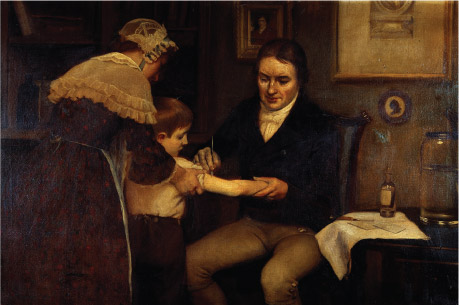2.7 Edward Jenner’s experiment
Jenner was aware of the country folklore that people who caught cowpox were also somehow protected from smallpox. Cowpox was a mild disease in cows and humans, characterised by the development of a small number of pustules on the skin that resembled smallpox pustules, but resolved without causing much concern.
In 1796, Jenner put the folklore to the test in an astonishingly risky and entirely unethical experiment by modern standards (Box 1). Jenner took pus from cowpox pustules on the hand of a dairymaid and rubbed it into scratches he made on the arm of an eight-year-old boy, James Phipps, the son of his gardener (Figure 10). James developed mild cowpox, from which he quickly recovered. Some weeks later, Jenner scratched James’s arm again and introduced pus from smallpox pustules – a procedure that he repeated on several occasions. Thankfully, Jenner’s experiment was successful and James did not develop smallpox.

Jenner had no knowledge of what caused smallpox or why exposure to cowpox was protective, but he spent the rest of his life promoting his method and supplying dried cowpox matter to people all over the world. The term vaccination is derived from vacca, the Latin for cow, reflecting its origins in Jenner’s experiments. Nowadays, vaccination and the modern term immunisation are used interchangeably to refer to exposure of an uninfected person to a vaccine, i.e. material derived from an infectious organism, which provokes a protective response from the recipient’s immune system if the recipient is subsequently exposed to the live organism from which the vaccine was derived.
Box 2.7.1 Box 1 Ethics in medical and scientific experiments
We’ve said that Jenner’s experiment on James Phipps was ‘unethical’ by modern standards, but what does this mean? Medical ethics is a set of principles that govern the way that doctors and other health professionals conduct their interactions with patients. These principles began with the Hippocratic Oath, which is still sworn in one version or another in many countries when doctors graduate from medical training. The portion of the oath that relates most closely to Jenner’s experiment translates roughly as:
I will prescribe treatments for the good of my patients according to my ability and my judgement and never do harm to anyone.
Jenner certainly intended to ‘do good’ to James Phipps by protecting him from smallpox, but he could also have caused great ‘harm’ if James had died from the disease. If he had carried out his experiment today, Jenner would have been struck off the Medical Register, meaning that he could no longer practice as a doctor.
The modern-day principles of medical ethics are summarised as follows:
- respecting the patient’s autonomy – the right to be involved in all aspects of their treatment and to have their wishes respected
- acting in the patient’s best interests (known as the principle of ‘beneficence’)
- doing no harm to the patient (the principle of ‘non-maleficence’)
- maintaining justice, fairness and equality of treatment for all patients
- communicating clearly and truthfully to ensure informed consent to treatment and other interventions
- maintaining confidentiality about the patient’s medical condition, which should not be discussed with anyone except health professionals involved in their care without the patient’s consent.
If a medical or scientific experiment involving humans or other animals as subjects is conducted today, the researchers must first obtain permission from the relevant Research Ethics Committee governing the proposed research.
